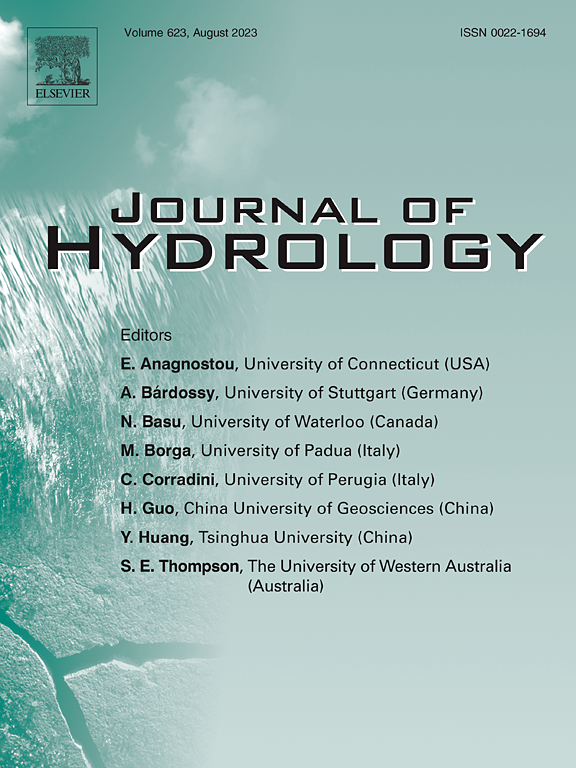Should we average rain gauge values to estimate throughfall? A research of canopy structure and throughfall spatial variability using LiDAR technology
IF 5.9
1区 地球科学
Q1 ENGINEERING, CIVIL
引用次数: 0
Abstract
Throughfall () is a significant component in hydrological studies of forest ecosystems that characterize subcanopy precipitation () inputs. Previous studies averaged the observations from rain gauges placed uniformly under the canopy. However, variations in canopy structure and the spatial distribution of canopy density led to measurement variability across locations, even in single-species plantation forests. 3D forest point clouds were reconstructed using a drone LiDAR system and a voxelization method was employed to compute the volume of leaves at rain gauges and individual tree scales to describe the canopy structure. Canopy saturation was assessed by observing changes in the proportion of direct from high-temporal-resolution rain gauge data and correlating these patterns with quantitative canopy structure, a volume- model was built to characterize the challenge of raindrops passing through the leaves. In addition, the conversion rate was corrected by considering the amount of canopy saturation and proportion changes before and after saturation. After inputting the volume and parameters, the accuracy of the model was verified at the rain gauge scale with R2 = 0.8239 – 0.9906 (n = 70). The modeled results showed that during the observation period was 53.24 %, which was slightly lower than the average of the 20 rain gauges over 265 rainfall events (63.21 %). Spatial variability significantly affected generation during changes in rain gauge location (coefficient of variation () = 0.64) compared with Pg ( = 0.3). The incorporation of saturation improved the model accuracy (RMSE; 3.69 mm > 3.28 mm,). This suggests that the method of averaging the 20 rain gauges to estimate results in limited confidence owing to the spatial variability of the canopies. Our model quantifies the spatial variability of canopy and , contributing to the construction of more robust and precise hydrological models, effectively capturing stand heterogeneity and enabling targeted forest management practices.
我们应否取雨量计的平均值来估计雨量?基于激光雷达技术的冠层结构与穿透空间变异性研究
通过降雨(TF)是表征林冠降水(Pg)输入特征的森林生态系统水文研究中的一个重要组成部分。以前的研究平均了均匀放置在树冠下的雨量计的TF观测值。然而,冠层结构和冠层密度空间分布的变化导致了不同地点的测量变异,即使在单一物种人工林中也是如此。利用无人机激光雷达系统重建三维森林点云,并采用体素化方法计算雨量计和单树尺度下的树叶体积,以描述林冠结构。通过观测高时间分辨率雨量计数据中直接水分水分比例的变化来评估冠层饱和度,并将这些变化与定量的冠层结构相关联,建立了一个体积-水分水分模型来表征雨滴通过叶片的挑战。此外,考虑冠层饱和量和饱和前后的水分比例变化,对水分转化率进行了校正。输入体积和Pg参数后,在雨量计尺度上验证模型的精度,R2 = 0.8239 ~ 0.9906 (n = 70)。模拟结果表明,观测期间的TF/Pg值为53.24%,略低于20个雨量站265次降水事件的平均值(63.21%)。与Pg (Cv = 0.3)相比,空间变异显著影响雨量计位置变化时的TF生成(变异系数(Cv) = 0.64)。饱和度的加入提高了模型精度(RMSE;3.69 mm >;3.28毫米,)。这表明,由于冠层的空间变异性,用20个雨量计的平均值来估计TF的方法可信度有限。我们的模型量化了林冠和林分的空间变异性,有助于构建更稳健、更精确的水文模型,有效地捕捉林分异质性,实现有针对性的森林管理实践。
本文章由计算机程序翻译,如有差异,请以英文原文为准。
求助全文
约1分钟内获得全文
求助全文
来源期刊

Journal of Hydrology
地学-地球科学综合
CiteScore
11.00
自引率
12.50%
发文量
1309
审稿时长
7.5 months
期刊介绍:
The Journal of Hydrology publishes original research papers and comprehensive reviews in all the subfields of the hydrological sciences including water based management and policy issues that impact on economics and society. These comprise, but are not limited to the physical, chemical, biogeochemical, stochastic and systems aspects of surface and groundwater hydrology, hydrometeorology and hydrogeology. Relevant topics incorporating the insights and methodologies of disciplines such as climatology, water resource systems, hydraulics, agrohydrology, geomorphology, soil science, instrumentation and remote sensing, civil and environmental engineering are included. Social science perspectives on hydrological problems such as resource and ecological economics, environmental sociology, psychology and behavioural science, management and policy analysis are also invited. Multi-and interdisciplinary analyses of hydrological problems are within scope. The science published in the Journal of Hydrology is relevant to catchment scales rather than exclusively to a local scale or site.
 求助内容:
求助内容: 应助结果提醒方式:
应助结果提醒方式:


